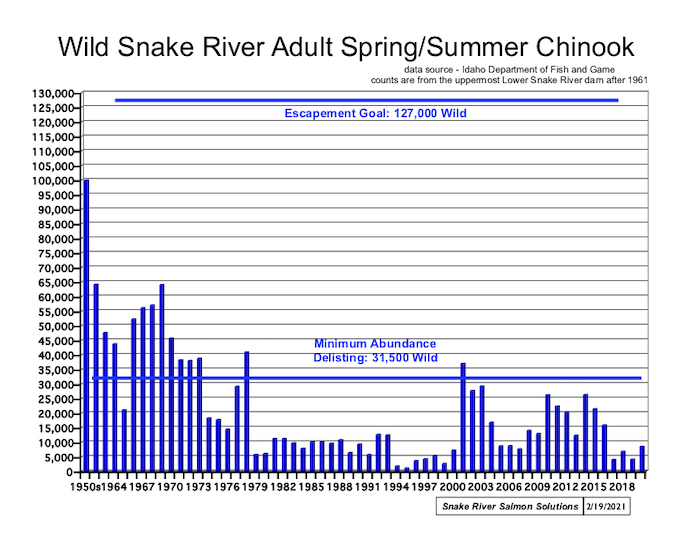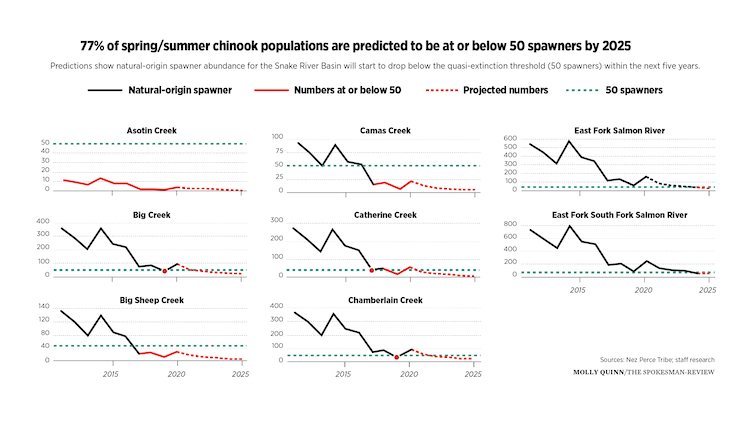forum
library
tutorial
contact

Lies, Damned Lies and Statistics --
The Story of One Misleading Claim About Salmon
by Shawn Vestal
Spokesman-Review, July 11, 2021
|
the film forum library tutorial contact |

|
Lies, Damned Lies and Statistics --
by Shawn Vestal
|
"Mr. Myers' presentation of adult fish count data at Lower Granite Dam is extremely misleading to the public
and does not represent a valid analyses of status of Snake River sockeye or chinook populations"
-- Michelle DeHart, Fish Passage Center
 Perhaps you got a taste of the latest bad cherry picked from the tree of facts about the salmon runs of the Northwest.
Perhaps you got a taste of the latest bad cherry picked from the tree of facts about the salmon runs of the Northwest.
If you did, spit it out.
The number of spring chinook returning to Lower Granite Dam on the Snake River was up from last year -- and last year it was up from the previous year. This is a glimmer of good news, though it does not substantially alter the pattern of salmon runs in the Northwest, almost all of which face extinction.
And yet, it was good enough for the Washington Policy Center -- the "think tank" that produces friendly facts for conservatives -- to claim as proof that the radicals and leftists are wrong on salmon. The WPC's Todd Myers, in a blog post that was subsequently turned into an op-ed that ran in several newspapers, including this one, said the numbers were a counterpoint to "dishonest, disingenuous, and unscientific arguments about salmon returns."
Reps. Cathy McMorris Rodgers and Dan Newhouse quickly parroted this claim, issuing a joint statement that the Lower Granite figures demonstrate that salmon are doing swell, "despite radical environmental groups trying to paint a picture of extinction."
Would it surprise you to hear that this cherry is three bushels short of a pie?
Chinook runs at the Lower Granite Dam were indeed up by 27% over last year, and last year was up 55% over the previous ones. That means more than 29,634 fish made it back past Lower Granite, which is significant because it's the last of eight dams they have to navigate to return from the ocean to their native spawning grounds.
In context, those numbers look less impressive. They are well below the 10-year average of 50,752, which is well below what's needed to bring back healthy salmon runs.
Terry Holubitz, a retired Idaho fisheries biologist with 40 years of experience studying the issue, called the latest numbers "a little bit of a blip" in a decades-long decline.
"They were better from one year to the next," he said, "but when you look at the whole program and all the years, they're not good at all for hatchery fish and the wild runs are terrible."
Erik Neatherlin, executive coordinator of the Governor's Salmon Recovery Office in Washington, has characterized Washington's salmon runs as "teetering on the brink of extinction" -- a fact that the news at Lower Granite does not reverse. Fourteen Washington salmon runs are listed as endangered.
"Yes, you might have a year-to-year uptick, but overall these species are in crisis," he said. "We still have a lot of work to do."
Not to put too fine a point on it, the manager of the Fish Passage Center -- the organization that gathers the fish counts cited by Myers -- has been outspoken about this statistical malpractice.
The manager, Michele DeHart, issued a written debunking of Myers' claims last year, when he issued similar pronouncements. In an interview last week, she reiterated the same concerns about this year's claims.
"Our overall conclusion is that Mr. Myers' presentation of adult fish count data at Lower Granite Dam is extremely misleading to the public and does not represent a valid analyses of status of Snake River sockeye or chinook populations," she wrote. "Mr. Myers has omitted major portions of historic facts and therefore presents conclusions that are not true."
The dam effect
In particular, DeHart said, Myers "mistakenly concludes that dam breaching is not necessary." She and others have long said that the four dams on the lower Snake River have pushed the salmon to near extinction, providing decades of evidence.
Salmon that have to pass three or four dams to return to their spawning grounds have managed to adjust and maintain healthy populations; but the additional four dams that the Snake River salmon have to navigate have a disastrous effect.
That's why 68 Northwest scientists issued a public letter in February saying that removing those dams is the only way to save the runs. It's why noted radical Mike Simpson, Idaho's Republican congressman, called this year to breach the dams as well, saying we're wasting millions upon millions in vain efforts to save the species with the dams in place, and noting that those four dams do not produce much power, relative to the entire Northwest hydropower supply.
Passionate opponents of dam removal have several arguments at their disposal, but it's frankly surprising they would attempt to argue the dams aren't doing what they're doing to salmon. The numbers making the case are available, after all, on the same web site that has the Lower Granite returns.
DeHart said an accurate measure of a healthy salmon run would be a 4% smolt-to-adult return rate -- the percentage of young fish that swims out to the ocean and then returns to spawn.
For the Snake River, SARs are only available up to 2018, but they are dismal year after year after year -- mostly below 1% and occasionally, at best, above 1%. The upticks at Lower Granite don't change that much, she said.
"One percent is replacement," DeHart said. "Anything less and the population is declining."
'Facing likely extinction'
These lousy replacement rates are true for both wild and hatchery salmon. But wild fish stocks are in worse shape generally, and this is an area of particular concern for those who study the runs.
Holubitz said that relying on hatchery fish to restore the runs is foolish. Even if there weren't concerns about eliminating the diverse range of regional fish species, hatchery fish are less able to survive the rigorous journey salmon must make to reproduce. Relying on hatchery fish to bring back salmon runs is a recipe for extinction, he said.
 "Wild runs are in terrible shape, and they're the ones that are important to the future," he said.
"Wild runs are in terrible shape, and they're the ones that are important to the future," he said.
The fish face obstacles in addition to the dams, including ocean conditions that are altered because of climate change. But those who favor dam-breaching note that several other salmon runs, which face the same set of other environmental factors but which have to pass fewer dams, are pretty healthy.
In the February letter calling for dam breaching, the scientists noted that the SAR for wild steelhead in the Deschutes River basin, above two dams, was 5% from 2006 to 2016.
In the John Day River, above three dams, wild steelhead SAR is 5% and wild chinook is 3.6%. In the Yakima River basin, above four dams, wild steelhead SAR is 4% and wild chinook is 2.5%
"By contrast, in the Snake River basin (above eight ... dams) all salmon populations are facing likely extinction," the letter said.
Myers issued his latest statistical analysis last week, an evaluation of the state's pandemic response in which he states flatly that the number of deaths above average in Washington last year -- which are not assigned causes -- were "caused by COVID-related restrictions."
One imagines this baldly unfounded claim will begin showing up in McMorris Rodgers news releases and newspaper columns, tout suite.
The salmon crisis is complicated, involving many species, river basins, competing environmental and economic interests, political conflicts, tribal treaty obligations, and, it seems, culture war divisions. It's hard to get your mind around any one part of it.
It's also impossible to extract a single number from the morass of data -- one fish count at one dam, for one or even two years -- toss away the rest, and claim that you are saying something true.
When you do that, you're just not telling the truth. You're making dishonest, disingenuous and unscientific arguments about salmon returns.
learn more on topics covered in the film
see the video
read the script
learn the songs
discussion forum
